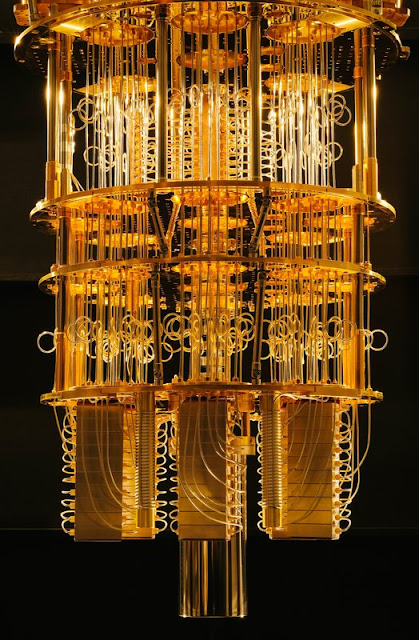Quantum Computing ?
Is the U.S. Lagging in the Quest for Quantum Computing?
An IBM Q cryostat used to keep IBM’s 50-qubit quantum computer cold in the IBM Q lab in Yorktown Heights, New York on March 2, 2018. In five years, quantum computing will go beyond the research lab and become mainstream, rapidly advancing the technology and its early use cases. Credit: IBM Research Flickr (CC BY-ND 2.0)
A quantum computer capable of breaking the strongest codes protecting online communications and computer data is highly unlikely to appear within the next decade, a new report says. But leading experts still recommend the U.S. government should prepare for that eventuality as many countries race to develop practical quantum computers.
Issued by The National Academies of Sciences, Engineering and Medicine,the report prescribes a healthy dose of skepticism for the quantum-computing fever that has infected tech news headlines and press releases in recent years. Contrary to some sensational claims, quantum computers will not completely replace classical computers anytime soon, if ever. And despite a spike in commercial interest, the short-term impact on the computing industry will probably be fairly small. “I think in the next year or two we won’t get to solving actual problems yet,” said John Martinis, a research scientist at Google and professor of physics at the University of California, Santa Barbara, during a press conference. “But there will be better machines out there, and excitement will pick up with the understanding that we are still doing basic science.”
Quantum computing’s promise comes from harnessing the interactions described by quantum mechanics at the universe’s smallest scales. If a bit of information is like a penny with only either “heads” or “tails” in classical computing, then a quantum bit (qubit) is somewhat like a round sphere for which one hemisphere is heads and the other is tails. By manipulating the sphere—rolling it around, for instance—one could put a qubit into a quantum state where it is 40 percent heads and 60 percent tails or 99 percent heads and 1 percent tails or evenly split 50–50. Existing quantum computers encompass a wide variety of architectures, using superchilled atoms, loops of superconducting metal and other exotic constructs as qubits.
The huge number of possible states in a single qubit could allow a quantum computer to execute much more complex computing operations than any conceivable classical computer. That raw power could be harnessed someday to perform tasks impossible for practical computers such as cracking the strongest cryptographic ciphers used by governments and companies or simulating quantum systems relevant to scientific fields such as physics, chemistry and biology. But before such feats can become a routine reality quantum computers must become much more practical and reliable.
ERROR, ERROR!
One of the greatest challenges is environmental “noise” from thermal fluctuations or physical vibrations that can disrupt the quantum states of qubits used to carry out computing operations. Those disruptions create errors that must be corrected in each affected qubit, and often emerge from the very systems engineers use to control and interact with qubits in the first place.
The end goal of the race for practical quantum computing is to create a fully error-corrected quantum computer that can handle all those noisy disruptions. Researchers are still trying to bring down error rates in quantum systems with just two-qubit operations but have not yet extended those error-correction methods to much larger arrays consisting of 50 qubits and more, which suffer from greater noise issues. “These machines are quite far away,” said Mark Horowitz, a professor of electrical engineering and computer science at Stanford University and chair of the committee behind the report, during the press event. “We need to have about 100,000 times more qubits than we have today, and we need to decrease the error rates of qubits by a factor of 100.”
A few skeptics even suggest building a practical quantum computer is impossible. Mikhail Dyakonov, a theoretical physicist at the University of Montpellier in France, believes engineers will never be able to control all the continuous parameters that would underpin even a 1,000-qubit quantum computer. In his view, error correction faces a hopeless task of handling potential disruptions emanating from that huge number of parameters, which would exceed the estimated number of atoms in the known universe. “At this point, I say this is impossible because there are too many of them and you can’t keep them all under your control,” Dyakonov says.
But it is possible to reduce the number of errors to a manageable amount, says Daniel Lidar, director of the Center for Quantum Information Science and Technology at the University of Southern California and an independent reviewer for the report. This involves encoding a stable logical qubit based on many noisy physical qubits working together to detect and correct errors—a bit like having underperforming students working together to triple-check one another’s work and create a more reliable team. “[B]y using more physical qubits per logical qubit, it becomes possible to correct more errors—and a threshold ‘noise level’ can be reached, below which a quantum computer that computes using its logical qubits is effectively noiseless,” he says. “The key to this is the digitization of continuous errors due to the use of quantum error correction.”
For now even noisy quantum computing devices without error correction could offer a useful “stepping stone” by demonstrating “quantum supremacy,” and completing any task that would stymie even the most powerful classical computers, Lidar says. But achieving quantum supremacy would still be easier than the next major milestone: commercially viable quantum computers that can perform practical tasks more efficiently than classical computers. That crucial step, he says, may require a combination of error-correction and error-suppression methodsreducing the baseline number of qubit errors to make practical quantum computing more scalable.
PREPPING FOR A QUANTUM FUTURE
The U.S. could still benefit from a better-safe-than-sorry approach even if quantum computing progress proves slow, said Bob Blakley, global director of Information Security Innovation at CitiGroup and co-author of the report. He said it would not hurt to develop and implement new “quantum-safe” cryptographic algorithms, especially because existing ciphers require regular refreshment anyway to minimize the chance of being cracked. “Even if we didn’t think quantum computing was likely to exist in 50 years or 100 years, we would still be engaged in an effort to replace the current generation of cryptographic algorithms on about the schedule we’re replacing them with quantum-safe algorithms,” he said.
The U.S. intelligence community may already be thinking along those lines, given the new report was written in response to a request from the Office of the Director of National Intelligence. But private investment in quantum computing has also been on an upswing. Leading tech companies such as Google, IBM and Intel have been developing their own test versions of quantum-computing architecture, along with start-ups such as D-Wave Systems in Canada and the U.S.-based Rigetti Computing.
If quantum computers fail to prove commercially viable in the short term, quantum-computing research may need additional backing by the government. Until now federal funding for quantum computing research has been sporadic and spread out in uncoordinated fashion among various agencies. That may change with the National Quantum Initiative Act, which was introduced as legislation in July 2018 and aims to provide $1.275 billion in funding for a 10-year research effort. The bill cleared the House of Representatives in September and now requires the Senate to take up its cause.
The initiative could get a boost from both the report’s findings and from growing fear of the U.S. falling behind as other countries step up. China has announced an $11.4-billion national quantum-computing effort. Similarly, the European Union has committed $1.1 billion over 10 years. The U.K. is investing $358 million over five years. Even Australia and Canada have launched their own initiatives.
“It’s going to be easy to cede the lead here to other countries that are taking a proactive and aggressive approach,” Lidar says. “We absolutely must have a national direction that is well funded and enjoys bipartisan support.”




Comments
Post a Comment